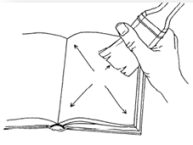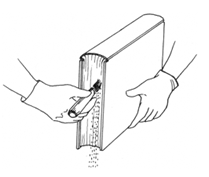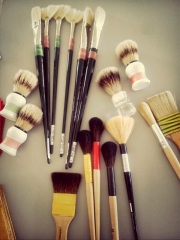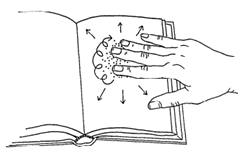Steps to dry clean;

The correct way to brush pages using a star-burst technique.
Source; BonaDea, A., 1995. Conservation Book Repair A Training Manual. Juneau: Alaska State Library, Alaska Department of Education.
- Always brush from the center of the page out towards the edges in a star burst pattern and up and down the hinge area to remove dirt or insect eggs crumbs.
- Brushes can be any size but should have soft, natural bristles. NOT plastic or nylon bristles or dusters as they can scratch.
- The best type of brushes to use are shaving brushes, sable paint brushes and jewellers and watchmakers brushes.
- Dry brushes should not be used for water, paste or glue as they compromise the bristles.
- Be mindful of pre-existing paper tears so that the brush does not snare.
- The top of books should be cleaned closed and brushing done from the spine down.
- After dry cleaning, products like Opaline or Skum-X (eraser products) can be used to remove more stubborn surface dirt.
- Using clean fingers or a soft clean cloth, rub the paper lightly in a circular pattern. Work in a circular motion from the center of the page toward the outside edge, with care taken on the edges of pages as they tear easily.
- The pressure applied during this process should be kept to a minimum.
- Eraser crumbs change colour upon picking up dirt. Once they seem to have picked up as much dirt as possible use the dry cleaning method to brush the eraser crumbs off the page.
- Repeating the method can be helpful if the pages don’t appear clean, but if the eraser crumbs don’t change colour it means they have picked up as much dirt as possible.

Brush down the top of the textblock away from the spine to remove dirt and dust.
Source; BonaDea, A., 1995. Conservation Book Repair A Training Manual. Juneau: Alaska State Library, Alaska Department of Education.
NB# when cleaning a book, you might want to think about using a low suction vacuum to make sure dirt and dust does not simply redistribute somewhere else in the book or collection. A simply way for reducing the suction on a vacuum cleaner is to cover one end with a gauze-like material like fine, nylon stockings.
Pencil notations;
While unfortunately pen notations in books are usually permanent, pencil notations can be easily removed. Using products like Opaline or Skum-X and the steps already outlined will remove pencil marks but if you don’t wish to clean the entire page, then a vinyl eraser like Faber Castell brand Magic-Rub (as they tend to be less abrasive than other forms of erasers), can be used. Erase in one direction only and not back and forth, starting towards the center of the page and working your way towards the edge. Again dry brushing using the star burst shape can remove eraser crumbs.


